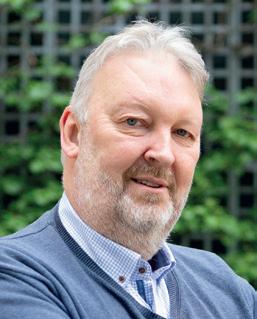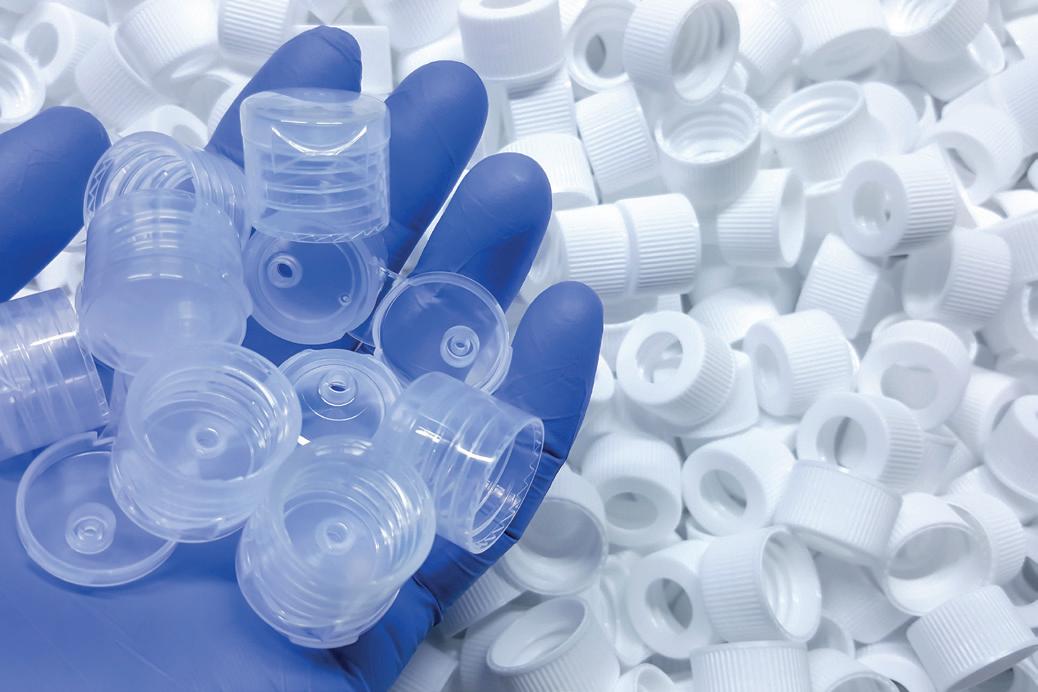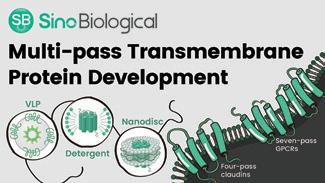Faster smarter clinical trials

Emmanuel Ladent, CEO at Carbios SAS, on how plastics production
circularised using the firm‘s enzyme platform.



Emmanuel Ladent, CEO at Carbios SAS, on how plastics production
circularised using the firm‘s enzyme platform.

Experience newfound clarity with the Nexera XS inert UHPLC. Offering reliable, robust performance, the Nexera XS inert represents a new peak in the analysis of biopolymers. It features a metal-free sample flow path prepared from corrosion-resistant materials, so that results will be clear and unaffected by sample adsorption or surface corrosion. Together with a new range of consumables, Shimadzu now offers the complete solution for bioanalysis.
Unconstrained recovery and sensitivity

Bioinert flow path prevents sample loss due to adsorption.
Clear resolution without restrictions
UHPLC performance for high efficiency bioanalysis.

Assured reliability and reproducibility
Corrosion-resistant material ensures long-term stability and reliable data acquisition.

The bioeconomy can be a major driver in bringing circularity, sustainability and competitive production to Europe as it aims towards becoming climate-neutral and more self-sufficient.
The value of Europe’s bioeconomy grows every year. BIC commissions the Nova Institute to produce an annual report on the bioeconomy. The bioeconomy employs 17.6 million people in Europe, with a turnover of more than €2.4 trillion in 2019, an increase of 25% since 2008. The bio-based industries in particular show strong growth, contributing more than €814 billion to the 2019 figure.
DIRK CARREZ is the Executive Director of BIC. He holds a PhD in Agricultural Sciences. He has been Director of Innovation & Product Policy at the Belgian Federation for the Life Sciences and Chemical Industry, Secretary-General of the Belgian Biotechnology Industry Association, and Director of Industrial Biotechnology at EuropaBio. Dirk is Vice-Chair of BIAC’s (Business and Industry Advisory Committee to the OECD) Biotechnology Committee, and part of several European and national advisory bodies.
BIC has been the partner of the European Commission in two publicprivate partnerships aimed at growing Europe’s bio-based industries – the Bio-based Industries Joint Undertaking or BBI JU (20142020) and the Circular Bio-based Europe Joint Undertaking or CBE JU (2020-2027). The bio-based sector is developing flagship “first-of-their-kind” biorefineries producing innovative bio-based products, either new or replacing fossil-based counterparts. The partnerships have already resulted in 13 of these biorefineries across Europe including France, Latvia, Norway and Romania. The bioeconomy’s rise in prominence on the EU’s policy agenda is a strong sign of how important it has become. The EU has placed the bioeconomy at the heart of several political initiatives, including the EU Bioeconomy Strategy (first adopted in 2012 and revised in 2018); the European Green Deal (2019) and the Circular Economy Action Plan (2020).
As recently as April 2023, the EU Council recommended the European Commission to further integrate bioeconomy into all policies. Better recognition in EU policy is indeed essential to unlock the potential of the bioeconomy. Regions outside Europe are boosting their investments. Examples include China’s 14th Five-Year Plan and US initiatives such as the Inflation Reduction Act and their strategy to bolster domestic biomanufacturing.
The bioeconomy can and should grow at a faster pace, so the greener solutions it provides become more widespread and adopted by consumers. There is rightly a lot of focus on innovation, but there is a need for more funding to scale-up and commercialise these new technologies to overcome the “valley of death”. Improving access to funding (EU, national, regional, private) is still a challenge. At BIC, we try to address this in a number of ways, including a pitching event where bio-based SMEs can meet with some of the most active venture capital, corporate and angel investors. But access to renewable feedstock and stimulating market demand are also crucial for the further development of this strategically important sector.
The road ahead for Europe’s bioeconomy looks bright – with new investments, revenues, innovations and jobs. However, Europe needs to go faster and further.

Although 18 million people die of cardiovascular diseases every year, the pharma industry has limited its clinical research on new heart drugs for cost reasons. To gain market approval in the past, tens of thousands of heart patients had to be recruited for trials. But now advances in biological pattern recognition promise to dramatically improve patient selection. The changing paradigm has led cardiologists to call for a fundamental shift in ICH guidelines in order to help get new treatments to doctors and patients faster.
6 Experts shed light on progress in the fight against antimicrobial resistance
8 It aly to ban cell-based protein from market; FAO to establish cell-based protein surveillance
10 Interview:
Dr Marc Gitzinger, CEO BioVersys AG, Schlieren, President of the Board, BEAM Alliance
15 European Commission’s pharmaceutical package under fire from industry
16 Analyst commentary: Peter Thilo Hasler, Founder & Research Analyst at Sphene Capital GmbH
17 European Biotech Stocks
20 Interview: Emmanuel Ladent, CEO, Carbios SAS, Clermont-Ferrand, France 24
54 Northern Europe: Sweden, Denmark, Norway and Finland
56 We stern Europe: France, Belgium, The Netherlands and the UK
58 Central Europe: Germany, Switzerland and Austria
60 Southern Europe: It aly, Spain, Greece, Slovenia and Portugal
62 Ea stern Europe: Poland, Hungary, and Lithuania
63 Covestro AG and academic r esearchers find plastic-eating enzyme cracking ether bonds
64 CRISPR-based virus-killers; How high blood pressure reprogrammes macrophages
PICK & MIX
65 News from Biotech Austria, A seBio, Sweden Bio, GASB and the SBA
30
71 Biopeople
72 Company index / New products
73 Events
74 Encore
IMPRINT European Biotechnology (ISSN 2364-2351) is published quarterly by: BIOCOM AG, Jacobsenweg 61, D-13509 Berlin, Germany, Tel.: +49-30-264921-0, Fax: +49-30-264921-11, Email: service@european-biotechnology.com, Internet: www.european-biotechnology.com; Publisher: Andreas Mietzsch; Editorial Team: Thomas Gabrielczyk (Editor in Chief), Derrick Williams (Co-editor), Dr. Georg Kääb, Uta Mommert, Gwendolyn Dorow, Margarita Milidakis, Maren Kühr; Advertising: Oliver Schnell, +49-30-264921-45, Christian Böhm, +49-30-264921-49, Andreas Macht, +49-30264921-54; Distribution: Lukas Bannert, +49-30-264921-72; Graphic Design: Michaela Reblin; Production: Martina Willnow; Printed at: Königsdruck, Berlin; European Biotechnology Life Sciences & Industry Magazine is only regularly available through subscription with a BIOCOM CARD. Annual subscription BIOCOM CARD Europe: €80 for private individuals (students €40) incl. VAT, €120 plus VAT for corporates. Prices includes postage & packaging. Ordered subscriptions can be cancelled within two weeks directly at BIOCOM AG. The subscription is initially valid for one calendar year and is automatically renewed every year after. The subscription can be cancelled at any time and is valid until the end of that calendar month. Failures of delivery, which BIOCOM AG is not responsible for, do not entitle the subscriber to delivery or reimbursement of pre-paid fees. Seat of court is Berlin, Germany. As regards contents: individually named articles are published within the sole responsibility of their respective authors. All material published is protected by copyright. No article or part thereof may be reproduced in any way or processed, copied, and proliferated by electronic means without the prior written consent of the publisher. Cover Photo: Karrrtinki - stock.adobe.com; ® BIOCOM is a registered trademark of BIOCOM AG, Berlin, Germany.
Along with improved recycling rates, an EU ban on single-use plastics may help reduce the mountains of garbage generated at rock festivals. But what about the waste generated by facilities that work with harmful microbes, viruses or genetically modified cellular products? Laboratories trying to go green walk a tricky tightrope.

Pull mechanisms are at the heart of incentivising the moribund market of novel antimicrobials. At the 7th AMR conference in Basel, Switzerland, E urop E an Biot E chnology met Dr Marc Gitzinger, President of the Board of the BEAM Alliance, who gave an update on what is under discussion in Europe and globally.

European biotech entrepreneurs would nod in agreement at a quote I recently heard at a conference: “The USA innovates, China produces and Europe regulates.” Facing global challenges involving the climate, resource scarcity, and species protection – alongside measures like public health and nutrition – we shouldn’t underestimate the braking effect that excessive bureaucracy has on scientific and economic output, and the circularisation of production processes (see p. 20, 50). It slows progress dramatically in Europe, as the European Commission now also recognises. Whether it’s number of clinical studies, degree of medical data digitalisation, approval times for sustainable cell-based protein alternatives (see p. 8) or pull mechanisms for urgently needed new antibiotics (see p. 6 & 10) – Europe lags behind when it comes to innovation, whatever verbal acrobatics politicians use when trying to deny it.
Attempts to improve – like the digital study portal CTIS or the draft of the new pharmaceutical regulation (see p. 15) – fail because of deceleration processes that are particularly pronounced in Europe, while developers and investors criticise them as being fundamentally flawed. Will cardiologist attempts (see p. 12) to adapt ICH rules for clinical trials to digital and biological progress have an impact? It’s just one more field that demands more nimble responses in a rapidly changing world.
Thomas Gabrielczyk Editor-in-Chief


CLINICAL TRIALS Although 18 million people die of cardiovascular diseases every year, the pharma industry has limited its clinical research on new heart drugs for cost reasons. This is because, in the past, tens of thousands of heart patients had to be recruited in Phase III studies to gain market approval. But now advances in biological pattern recognition promise to dramatically improve patient selection for clinical trials. Cardiologists are therefore calling for a fundamental shift in the rules for clinical trials, such as the use of real-world data to bring promising treatments to the market.

In the ranks of causes of death worldwide, cardiovascular disease is by far the number one killer. But attitudes towards it have remained static for decades. Even today, the public continues to view cardiovascular conditions as largely self-inflicted. Smoking, obesity, a lack of exercise, an unhealthy lifestyle and low social status are still considered the most common causes of high blood pressure, atherosclerosis, acute coronary syndrome, congestive heart failure or stroke. Much less well known is the fact that over 50% of cardiovascular diseases have other causes – often rooted in a patient’s genes. Recent advances in high-throughput molecular biology, in combination with machine learning / automated pattern recognition – and thus immensely improved patient stratification – have led to a renaissance in clinical cardiology research, which has long been blocked by vast patient collectives and associated gigantic costs. In 2015, former US President Barack Obama launched a programme funding personalised cardiology or 4P medicine (see p. 14).
Now the new possibilities are making waves all over the world. In Germany, cardiologists have called for a national cardiac strategy that makes use of new tools such as digitised real-world data, because they have the potential to make clinical trials much more affordable and effective, and allowing patient access to novel treatment. In the past, high costs drove pharmaceutical companies to withdraw from cardiovascular trials and instead to favour research into indications like cancer that required smaller study populations and shorter follow-up. Beyond Germany, in the rest of Europe, as well as the US, cardiologists motivated by research successes now want to rewrite the International Council for Harmonization (ICH) Good Clinical Practice (GCP) Guidelines to allow investigator-initiatied studies on cardiovascular drugs. Inspired by the principles of the Good Clinical Trials Collaborative, they are calling for a reinvention of randomised clinical trials (RCTs), reworking
them to fit the 21st century. At the end of March, leading lights in the field across Europe and the world trumpeted in four flagship cardiology journals that enough wa s enough. Current randomised clinical trials, they said, were no longer doing what they were supposed to do. “It is time to reinvent RCTs,” the European Society of Cardiology (ESC), the American Heart Association, the World Heart Federation and the American College of Cardiology announced simultaneously in circulation, the EuropEan hEart Journal, the Journal of thE a mErican collEgE of cardiology and gloBal hE art. “The costs and complexity of clinical trials have become prohibitively high,” stressed ESC President Franz Wiedinger.
The better way to DNA!
According to the position paper, the regulatory burden has grown so heavy that important clinical questions are no longer answered, while clinical trials never get off the ground. Burgeoning costs and bureaucracy easily get out of hand, which means study populations are often too small to provide strong evidence.
The possibilities forged during the COVID-19 pandemic are now set to reinvigorate a clinical trial landscape currently dominated by financially strong sponsors. The idea is to dramatically streamline trials, with key data collected fir st in RC Ts an d the bulk of follow-up information sourced – where possible – from national electronic health records and registries. At the heart of this ‘bottom-up revolution’ to make cardiologist-initiated and sponsored trials affordable is the digitalisation of follow-up. It will employ app-based data collection, remote patient monitoring and virtual study visits – things that were previously only possible in big pharma-initiated trials evaluated by regulatory authorities.
According to AHA President Michelle Albert, the joint societies “wish to engage in the development of guidance that allows broader use of real-world data,
Customized High Quality Grade DNA for GMP production of viral vectors, RNA and CAR-T cells























QC including CGE service pDG/pDP plasmids for AAV production





2 plasmid system
Serotypes including AAV8 & AAV9 GFP transfer plasmids

ITRRESCUETM In Stock service
Coming soon
With Omics and AI tools, we will be able to prevent 70-80% of cardiovascular deaths.
GREENER PACKAGING An EU ban on single-use plastics plus improved recycling rates may help lower the mountain of garbage generated at rock festivals, but what about the plastic waste generated by facilities that work with harmful microbes, viruses or genetically modified cellular products? Circularity for the plastic bags or pipettes used in potentially dangerous research is a tricky goal. What’s still missing are scalable alternative materials, along with standards for calculating carbon footprints over the entire added value chain.

The most frequently cited source you’ll find when looking for information on how much plastic is consumed by Life Sciences industries is this one: ”We estimate that the 280 bench scientists in our bioscience department generated roughly 267 tonnes of plastic [annually]. That is equivalent to about 5.7 million empty 2-litre plastic bottles. Some 20,500 institutions worldwide are involved in biological, medical or agricultural research (where plastic disposal is likely to be heaviest), so that could equate to around 5.5 million tonnes of lab plastic waste – roughly the combined tonnage of 67 cruise liners, and equal to 83% of the plastic recycled worldwide.”
Those figures are from 2014, and were pu blished back in 2015, and the pandemic years almost certainly increased the consumption of ‘lab plastic’ dramatically, as billions of doses of vaccine were administered and test centres in many places performed billions of COVID-19 tests. Still, the researchers from Exeter University who back then published those statistics in n atur E (https://doi. org/10.1038/528479c) started a ball rolling that has since led to many initiatives for more sustainability in lab work and research infrastructure. It set off a search for some missing fundamental data. Even the amounts of lab waste that end up as microplastics in the environment, oceans and ultimately back in food chains remains a mystery.
Around 400 million tonnes of plastic are produced annually, and about 40% of that is single-use – in other words, plastic that will be used only once before it is binned. It’s estimated that over eight million tonnes of plastic enter the world’s oceans each year, most of it originating from landfills.
But real sustainability is a much wider question, encompassing sustainable food, fuel, health and climate challenges. Many labs are working on solutions that involve measures like reducing energy usage, which is calculated to be 5-10
times higher in a lab per square meter than it is in office space. For example, lowering storage temperatures of samples from -80°C to -70°C can make a bigger difference than you might think, as can many other measures.
Using infrastructure in more effective ways can be another approach, but there regulations have to be taken into account. Filtering air from biosafety labs for example, involves multiple filters and circulation processes before it can be released into the environment. That process is energy-intensive, but rightfully required by the approval authorities. However, slightly reducing the number of cycles might in some cases be just as safe, and save large amounts of energy. Increasing the percentage of green power involved can also have an impact.
There’s still no replacement for many plastics in the lab, and without clear substitutes, circularity for them will remain wishful thinking. In some individual cases there are alternatives, but they continue to have a limited impact. These include:

Alternative materials like glass, metal, or plant-based materials can substitute for plastic in some laboratory applications. Glassware in some instances can be used instead of plastic containers, and bamboo or paper-based products can be used instead of plastic labware. Many labs already employ reusable glassware, stainless steel instruments and reusable plastic containers. Some new bio-based materials are also in the works.
Recycling is possible in some cases in theory. But far from all types of plastic labware can be recycled properly. Some companies have set up a return service for laboratory goods, but usually only for very specific products (such as storage boxes or racks) and th ey usually fir st have to be pr ecleaned and autoclaved.
Biodegradable plastics can best be implemented in the packaging for labware – in wrapping material for devices and kits, for example. For long-term storage of samples though, or for cell culture in dishes or bags, any natural degradation process would be an undesirable characteristic.
When it comes to regulations, there are a number of laws and rules that govern the use and disposal of plastic labware in different countries and regions. In the European Union for example, the SingleUse Plastics Directive aims to reduce the impact of certain single-use plastic products on the environment, including plastic labware. In the United States, there are several federal and state laws and regulations that govern the use and disposal of plastic products, including plastic labware. The area is no longer just fodder for image campaigns. Slowly but surely, sustainability is becoming a center-stage topic as regulations are cast into law.
A new generation of lab managers is using plastic waste statistics as drivers for change, and is publicly championing sustainability and environmental protection. They see that for a sector typically aimed at contributing to the welfare of society, it just makes sense to include environmental sustainability in the equation.
One of the most simple and effective ways to do that is by changing how plastics are used. Whether single-use pipette tips, gloves, tu bes, fla sks or be akers – plastics are everywhere in the laboratory. By implementing recycling and reuse programs and seeking out ways to reduce waste, research facilities, contract research organisations, and pharmaceu-
PHARMA SERVICES Transmembrane proteins play a variety of roles in physiological processes such as protein ligation, recognition, transport, anchoring, and transduction. Abnormalities in the function of transmembrane proteins are associated with a number of diseases. They are also important drug targets, with approximately 50% of drugs targeting transmembrane proteins. However, low expression, in vitro insolubility, unstable purification, and difficulty in maintaining natural conformation have limited their use in drug development.
Sino Biological is focused on developing multi-pass transmembrane protein products and has set up three platforms to provide important raw materials for earlystage drug development. These platforms include virus-like particles (VLP), detergent micelle, and nanodisc. Sino Biological offers custom services in addition to supplying multipass transmembrane proteins (4 pass: Claudin-6, Claudin-9, Claudin-18.1, Claudin-18.2; 7 pass: GPRC5D, CXCR4, and SSTR2) through these platforms.

Discover More Now! CONTACT
Sino Biological Europe GmbH Düsseldorfer Str. 40, 65760 Eschborn, Germany
+49(0)6196 9678656
cro-service@sinobiological.com www.sinobiological.com




